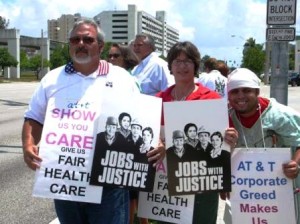The United Auto Workers and Communications Workers of America have joined forces in what the two unions describe as a “legislative alliance.”
UAW President Ron Gettelfinger and Larry Cohen of the CWA said each union would contribute staff and other resources to this alliance, which will be responsible for representing the interests of 2 million active and retired CWA and UAW members on legislative issues.
“Through this alliance, the two unions will increase the effectiveness of their legislative efforts in advancing the interests of their members and working families generally. In particular, the alliance will actively support passage of the Employee Free Choice Act, comprehensive, health-care reform, and measures to promote retirement security and fair trade,” Gettelfinger and Cohen said in a statement.
For all practical purposes, the alliance formalizes the cooperation that actually began a year ago during the Presidential campaign when both unions rallied behind Barrack Obama, UAW officials said. The cooperation was extended during the fight on Capitol Hill over the auto industry bailout, spawning the discussion about the possibility of closer collaboration.
As with many unions both the UAW and CWA are facing declining dues revenue and the alliance provides a way to leverage existing resources, UAW officials said.
The CWA’s IUE Division also represents autoworkers, particularly in Ohio.
Alan Reuther, the director of the UAW’s Washington office, will be the director of the CWA-UAW Legislative Alliance. The alliance will not only be involved in matters of vital interest to organized labor such as health care, it will also involve CWA and UAW members on issues related to the telecommunications and automotive industries.
However, both CWA and UAW officers went out of their way to emphasize that they will remain separate unions with independent bargaining, servicing, international affairs, political action and other operations.
The UAW held extensive talks about a possible merger with the United Steel Workers of America and International Association of Machinists in the mid-1990s. The merger proposal fell apart when the UAW board refused to go along with direct election of top officers by union members. The UAW chooses top officers in convention that is tightly controlled by the board and union staff.
However, the USW remains the most logical candidate to merge with the UAW. The USW shares the UAW’s history, having been created during the labor strife in the 1930s, and it has absorbed other old-line unions such as the United Rubber Workers of America in recent years.

